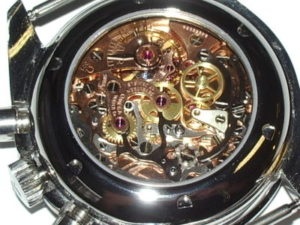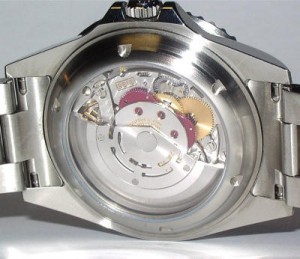You can probably get a custom display back for your watch, but do you really want to?
A frequent topic of discussion among watch collectors concerns the availability and feasibility of fitting sapphire display backs to watches that didn’t come from the factory thusly equipped.
Good news: yes, they’re available and they’re not terribly expensive or difficult to source and install. If you’re lucky and the manufacturer already offers a similar model featuring a display back, it can be as a simple as determining the appropriate part number, ordering the necessary part(s) through a willing source, and fitting appropriately.
And for those makes and models for which a display back is not already offered, there’s always Thomas Preik‘s custom sapphire display backs. Yes, the website hosted on a free webhost is slightly goofy-looking and the English version suffers from some failures of clarity owing to difficulties in translation from the original German, but Thomas is well-known in the collector community as a reputable and reliable source. Though I haven’t purchased myself I don’t hesitate to recommend him based on reputation. And of course, with a custom-designed back like this, you can still have the original to “return to stock” later if desired.

Omega Speedmaster Professional cal.321 ref 105.003 with custom sapphire display back. Though not intended for display backs, the c.321 is a common candidate among enthusiasts for an aftermarket display back conversion. Photo: Thomas Preik
Bad news: display backs are not always a good idea from both a functional and aesthetic standpoint, at least not necessarily.
A lingering concern is that using a sapphire caseback introduces one more potential point of failure of water resistance. And for dive watches in particular, since reliable water resistance is sometimes half the point of an expensive quality dive watch in the first place the wisdom of introducing potential points of failure could seem questionable.
Aftermarket modifications like this can void manufacturer and watchmaker service warranties as well. For older and vintage watches this may not be much of a concern, but it can be something worth considering for watches that are still under warranty. If this means you might be on the hook for an expensive service if something goes wrong, that sapphire display back could turn out to be an expensive “upgrade” modification. Of course, this is all assuming that it can even be detected that a display back was fitted at some previous point if the originalwere re-installed…
Preik guarantees the water resistance of his display backs to “at least 20 ATM” (or 200m) but even this begets some questions. For one, is it wise to deliberately downgrade the WR of the watch? Granted, many “desk divers” never get deeper than the deep end of the pool, but still the wisdom of intentionally degrading the water resistance seems slight.
Another point concerns the purpose: why would you even want a display back? Aesthetic vs. functional purpose, jewelry vs. tool: are you looking for a functional tool/instrument, or a pretty bauble to gawk at? Often movements are undecorated and are nothing really special to look at. Some makers like Omega even go so far as to add special design changes and finishing to movements on models with display backs to provide something at least a little more interesting to look at. But undecorated movements aren’t always really that much to look at once the initial novelty of being able to see that tiny mechanical heart beating wears off.
And then of course we get into the highly subjective field of fitness with the aesthete and character of the watch. Perhaps it’s just the purist vintage collector in me coming out, but I for one just plain don’t like display backs, especially when the watches in question were never intended for them. To me it seems inappropriate to turn a respectable “tool watch” (as much as I hate this term) into a visual spectacle, especially if its performance might be compromised by doing so. It threatens to cheapen the utilitarian aesthete, limits the performance, blasphemes the ideals
In the modern era, display backs are essentially an appeal to snootiness. They’re not necessary to the function of the watch itself, and are there solely to highlight that’s it’s a mechanical watch and (ostensibly) therefore remarkable and distinctive. But a well-designed watch should be able to capture the viewer’s heart already without whoring itself out with gimmicks like display backs in my opinion. If such gimmicks are necessary to enjoy the watch, you haven’t found the right watch yet. Though mechanical watches are somewhat unique and distinctive in this modern era of disposable quartz watches, when these now vintage watches were new no one wanted to see the inner workings. They were left to humbly serve their functions in silence and solitude, with appreciation and prestige drawn from their ability to do so reliably, consistently, and precisely. It would have been like a clear display window that allowed one to see the inner workings of a commode: who would want to see that anyway, and how does it serve the primary function of the device?
If you’re feeling the jones to gaze upon that movement and partake in the wonderment of that mechanical heartbeat, one that can’t be sated by viewing pictures online, why not just get an inexpensive mechanical watch with a factory display back like a Seiko 5 automatic rather than debasing, risking, and/or devaluing your precious? If nothing else, the total cost is even cheaper and the originality of the other watch unaffected.



Recent Comments